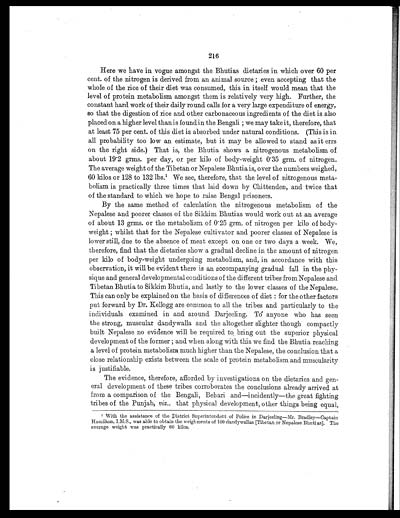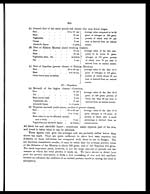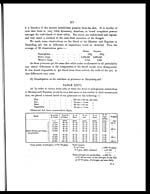Medicine - Institutions > Army health reports and medical documents > Scientific memoirs by officers of the Medical and Sanitary Departments of the Government of India > Number 37 - Investigations on Bengal jail dietaries > Part II > Relationship of food to physical development
(226) Page 216
Download files
Individual page:
Thumbnail gallery: Grid view | List view

216
Here we have in vogue amongst the Bhutias dietaries in which over 60 per
cent. of the nitrogen is derived from an animal source; even accepting that the
whole of the rice of their diet was consumed, this in itself would mean that the
level of protein metabolism amongst them is relatively very high. Further, the
constant hard work of their daily round calls for a very large expenditure of energy,
so that the digestion of rice and other carbonaceous ingredients of the diet is also
placed on a higher level than is found in the Bengali; we may take it, therefore, that
at least 75 per cent. of this diet is absorbed under natural conditions. (This is in
all probability too low an estimate, but it may be allowed to stand as it errs
on the right side.) That is, the Bhutia shows a nitrogenous metabolism of
about 19.2 grms. per day, or per kilo of body-weight 0.35 grm. of nitrogen.
The average weight of the Tibetan or Nepalese Bhutia is, over the numbers weighed,
60 kilos or 128 to 132 lbs.1 We see, therefore, that the level of nitrogenous meta-
bolism is practically three times that laid down by Chittenden, and twice that
of the standard to which we hope to raise Bengal prisoners.
By the same method of calculation the nitrogenous metabolism of the
Nepalese and poorer classes of the Sikkim Bhutias would work out at an average
of about 13 grms. or the metabolism of 0.25 grm. of nitrogen per kilo of body-
weight; whilst that for the Nepalese cultivator and poorer classes of Nepalese is
lower still, due to the absence of meat except on one or two days a week. We,
therefore, find that the dietaries show a gradual decline in the amount of nitrogen
per kilo of body-weight undergoing metabolism, and, in accordance with this
observation, it will be evident there is an accompanying gradual fall in the phy-
sique and general developmental conditions of the different tribes from Nepalese and
Tibetan Bhutia to Sikkim Bhutia, and lastly to the lower classes of the Nepalese.
This can only be explained on the basis of differences of diet: for the other factors
put forward by Dr. Kellogg are common to all the tribes and particularly to the
individuals examined in and around Darjeeling. Tó anyone who has seen
the strong, muscular dandywalla and the altogether slighter though compactly
built Nepalese no evidence will be required to bring out the superior physical
development of the former; and when along with this we find the Bhutia reaching
a level of protein metabolism much higher than the Nepalese, the conclusion that a
close relationship exists between the scale of protein metabolism and muscularity
is justifiable.
The evidence, therefore, afforded by investigations on the dietaries and gen-
eral development of these tribes corroborates the conclusions already arrived at
from a comparison of the Bengali, Behari and—incidently—the great fighting
tribes of the Punjab, viz., that physical development, other things being equal,
1 With the assistance of the District Superintendent of Police in Darjeeling—Mr. Bradley—Captain
Hamilton,I.M.S., was able to obtain the weighments of 100 dandywallas [Tibetan or Nepalese Bhutias]. The.
average weight was practically 60 kilos.
Set display mode to: Large image | Zoom image | Transcription
Images and transcriptions on this page, including medium image downloads, may be used under the Creative Commons Attribution 4.0 International Licence unless otherwise stated. ![]()
| Permanent URL | https://digital.nls.uk/75033393 |
|---|




